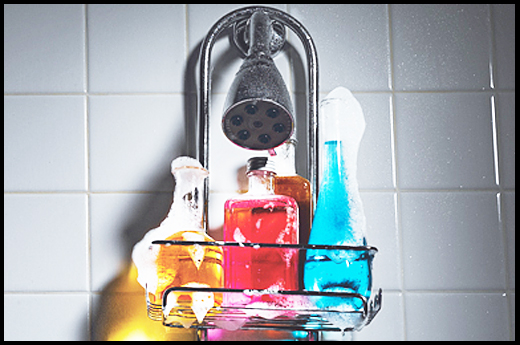by guest blogger Isaac Eliaz, MD, MS, LAc, integrative medicine pioneer
When embracing a healthy lifestyle, there’s one thing we learn over and over: healthy living requires vigilance. This is true of food and exercise, and, especially, the products we buy.
Like so much in modern life, shampoos and hair care products often contain too many ingredients that were born on a chemist’s bench. These chemicals are absorbed through the skin and into the bloodstream, and from there they can wreak havoc on organs, tissues, and cells. Luckily, there are many reputable natural health companies that are aware of these dangers and use healthy cleansing agents in their body products instead.
Toxin Alert
But, unless you’re extremely careful, it’s pretty much impossible to avoid all exposure to harmful, health-robbing toxins. Here’s a list of common chemical offenders found in many shampoos:
- Parabens: A common preservative used to eliminate bacteria and fungi in cosmetics, parabens have been linked to increased estrogen levels, which can lead to hormonal disorders and even cancer.
- Quaternium-15: A preservative that releases formaldehyde and has been linked to cancer, specifically leukemia, quaternium-15 is also an allergen and can cause contact dermatitis.
- Fragrance: We would need an entire book to list all the ingredients found in the various fragrances used in shampoos and skin products. These can cause allergic reactions, rashes, headaches and nausea. Some fragrance compounds have been linked to cancer.
- Methylisothiazolinone: Often abbreviated on ingredients lists as MIT, this preservative is found in a wide variety of shampoos and has been linked to neurological damage, particularly in unborn children. MIT has also been linked to Alzheimer’s disease.
- Sodium lauryl sulfate and sodium laureth sulfate: Abbreviated SLS and SLES, these surfactants make soaps foamy. They can also cause skin and eye irritation and have been linked to endocrine disruption, genetic mutations, and cancer.
- 1,4-dioxane: Not an ingredient so much as a contaminant, however, it’s been found in 22 percent of the products in the Skin Deep Database from the Environmental Working Group. This is cause for concern. The Environmental Protection Agency classifies dioxane as a probable carcinogen.
What to Do
The first line of defense is prevention. Do whatever you can to keep these chemical compounds off your skin as much as possible. But again, these toxins are so common that it’s difficult to avoid them entirely. Luckily, there are a number of ways to protect your health in the presence of these harmful pollutants.
Eat protective nutrients. Many of the harmful chemicals in shampoos and body products have an oxidative effect, which can wreak havoc on cells, tissues, and organs by causing chronic inflammation and free radical damage. Antioxidants combat these effects, particularly vitamin C, vitamin E, vitamin A and beta-carotene, alpha lipoic acid, N-acetyl-cysteine, and others. Fresh berries, nuts, cruciferous and colored vegetables, and numerous herbs and spices are also high in antioxidants.
Add botanical supplements. Calendula, honeysuckle, astragalus, and rehmannia root can help protect the skin from irritation and other damage. Calendula and honeysuckle are flowers and usually steeped in hot water to make tea. Astragalus and rehmannia are roots and are often ground into a powder and mixed with water, or put into a capsule or tablet form, along with other herbs. Calendula and honeysuckle are also commonly used topically to soothe irritated and inflamed skin. Using herbs both topically and orally can provide greater benefits.
Enlist detox helpers. Once harmful chemicals are in your body, you want to do what you can to get them out. A number of dietary supplements, botanicals, foods, and specific cleansing diets can help detoxify many of these pollutants.
Seven of the top natural ingredients that offer powerful yet gentle whole-body detoxification are:
- Medicinal mushrooms: Reishi, agaricus, cordyceps, coriolus, maitake, and umbellatus, along with many other types, help to remove toxins from the body. Detoxifying mushrooms can be cooked in meals, taken as supplements, or mixed in powdered form in hot water for tea.
- Dandelion (leaf and root): Dandelion root provides powerful support for cleansing the liver and the gallbladder—two key organs essential for detoxification. The leaves also help flush toxins from the bladder and digestive tract. Dandelion can be eaten raw or cooked, taken in supplement form, or drunk as a tea.
- Milk thistle seed: The herb’s seeds contain silymarin, a natural compound that is shown to be a potent liver protector and detoxifier. Milk thistle seeds support gall bladder health, as well, while also providing antioxidant and anti-inflammatory benefits. Most often, milk thistle seed is taken as a supplement.
- Garlic: Garlic contains many sulfur compounds and other active components to support detoxification, heavy metal removal, and overall immune health. It can be eaten raw or cooked, or taken in supplement form. Some people juice a small amount and mix it with other vegetable juices.
- Modified citrus pectin and modified alginates formula: These two ingredients are shown to safely remove heavy metals and toxins from the digestive and circulatory systems, without affecting essential minerals. They are taken as a supplement.
- Cilantro: A flavorful herb, cilantro binds to and helps remove heavy metals and toxins from the body. It also provides powerful antioxidant and anti-inflammatory benefits. The leaves and stems can be eaten raw in salads and salsas, juiced raw, or taken as a supplement.
- Burdock root: This antioxidant, anti-inflammatory herb supports healthy liver detoxification and helps cleanse the circulation of toxins. It can be eaten raw in salads, cooked, or juiced; alternately, you can use it in tea or take it in supplement form.
Gentle seasonal detoxification is an important practice to adopt. Toxins multiply in our bodies from countless sources, not just shampoo and skin-care products.
Good information translates into good choices. Pay close attention to ingredient lists, research anything that troubles you, and, from there, you can adopt the best strategies to reduce these harmful effects. Simply “rinse and repeat”—this time using healthy cleansers made from plant-based ingredients.
 Isaac Eliaz, MD, MS, LAc, integrates Western medicine with his extensive knowledge of traditional Chinese, Tibetan, Ayurvedic, homeopathic, and complementary medical systems. With more than 25 years of clinical experience and research, Dr. Eliaz has a unique holistic approach to the relationship between health and disease, immune enhancement, detoxification, and cancer prevention and treatment. For more information about his work, visit dreliaz.org.
Isaac Eliaz, MD, MS, LAc, integrates Western medicine with his extensive knowledge of traditional Chinese, Tibetan, Ayurvedic, homeopathic, and complementary medical systems. With more than 25 years of clinical experience and research, Dr. Eliaz has a unique holistic approach to the relationship between health and disease, immune enhancement, detoxification, and cancer prevention and treatment. For more information about his work, visit dreliaz.org.





Dr. Eliaz left out another avoidance option–skip shampoo all together. I’ve been washing my hair with baking soda (and occasionally apple cider vinegar) for months, if not a year now, and I don’t miss shampoo at all!
Dana, I have done the baking soda and ACV rinse, I haven’t used commercial shampoos since early March of this year. However, my hair felt yucky and I was extremely frustrated. I even tried a coconut milk shampoo from the Wellness Mama’s website, with no luck… So… what I found out is if you have hard water in your house (and we have super hard water), using natural methods of cleaning your hair will make you feel yucky, like I did. until I got a water softener, and the difference is AMAZING. TOTALLY. So, for everyone who tries the natural method, no poo method, etc. and get dismayed at it not working, think about a water softener. I know, sad that we got a water softener just for my hair, but it affects everything — the laundry, the dishes, your skin, etc. So totally worth it to me. I am now using the coconut milk shampoo (with dr. bronners castille soap and coconut milk and essential oils) along with an ACV rinse when I clean my hair and it feels SO wonderful. I am so happy with it. It is super shiny, and normally you equate shininess with oils.. but then you feel my hair and no oils or anything, usually after the first day my hair would get oily at the roots and no more!! Just healthy shine and no toxins! 🙂
I won’t go back to regular commercial, toxic shampoo ever again!
@Rebecca: I have heard that about the hard water. Glad you found a good solution, and a good routine that works for you.
This is why I switched to a natural shampoo brand (pro naturals moroccan argan oil shampoo) because the talk of toxins scared me. Less foam, but healthier hair!
WHY NOT GIVE US THE NAMES OF THE SHAMPOOS WE SHOULD NOT BE USING, OR AT LEAST GIVE US THE NAMES OF THE ONES WE SHOULD…..
Google gugo
How do you wash your hair with baking soda? Would like to try it.
How do you wash your hair with baking soda? I would like to try it.
I use aveda shampoo
Great Article! I have had a problem with my scalp for over a year. I tried changing products and using all organic but nothing helped. A few months ago my PA suggested I try Bumble and Bumble Gentle Shampoo. The shampoo has taken care of the itchy patches however I still have a lot of dryness that I attribute to the hard water.